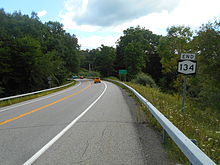New York State Route 134
Map of Westchester County in southeastern New York with NY 134 highlighted in red | ||||
| Route information | ||||
| Maintained by NYSDOT | ||||
| Length | 6.35 mi[1] (10.22 km) | |||
| Existed | 1930[2]–present | |||
| Major junctions | ||||
| West end | ||||
| East end | ||||
| Location | ||||
| Country | United States | |||
| State | New York | |||
| Counties | Westchester | |||
| Highway system | ||||
| ||||
New York State Route 134 (NY 134) is a 6.35-mile (10.22 km)
Taken over by the state of New York between 1908 and 1926, NY 134 was assigned to its current alignment as part of the 1930 renumbering of state highways in New York. In 1960, in conjunction with construction of the Watson Research Center, an interchange was added to NY 134 for the Taconic.
Route description
NY 134 begins at an intersection with

Past NY 9A, NY 134 heads northeast across the northern fringe of Ossining, climbing uphill as it passes Purdy Pond and crossing into the town of New Castle. Here, the homes gradually diminish in number, with dense woods taking their place. This trend continues into the adjacent town of Yorktown, where NY 134 becomes Kitchawan Road. About 1 mile (1.6 km) from the town line, the highway entering an interchange with the Taconic State Parkway. For a short distance after the interchange, NY 134 becomes four lanes as the road serves IBM's Thomas J. Watson Research Center. It narrows to two lanes past the facility, from where the highway takes a slightly more easterly track across Yorktown to reach the Kitchawan Preserve on the southern edge of the New Croton Reservoir.[3]
At this point, the road makes a turn to the southeast to enter the small
History

The origins of NY 134 date back to the late 1900s when the state of New York improved the portion of the route outside of the Ossining village limits to state highway standards. A contract for the $59,973 project (equivalent to $1.96 million in 2024) was awarded on June 30, 1908, and the rebuilt road was added to the state highway system on August 1, 1910, as unsigned State Highway 768 (SH 768).[5][6] Its continuation into the village limits was taken over by the state by 1926.[7] Neither state highway had a posted route number until the 1930 renumbering of state highways in New York, when hundreds of state-maintained roads were given signed designations for the first time.[8] The two state highways were combined to create NY 134.[2]
In 1960, a new interchange was built between NY 134 and the Taconic State Parkway as part of the construction of IBM's Thomas J. Watson Research Center. During the excavation process for the junction, a bone from a woolly mammoth (colloquially known as Jefferson's mammoth) was found buried in the earth below. The bones were moved to the New York State Museum in Albany. The construction also required the relocation of the Kitchawan Tavern from the site of the exit to the junction of Kitchawan and Chadeanye roads a half-mile (0.8 km) to the east.[9]
Major intersections
The entire route is in Westchester County.
| Location | mi[1] | km | Destinations | Notes | |
|---|---|---|---|---|---|
| Village of Ossining | 0.00 | 0.00 | |||
Town of Ossining | 1.41 | 2.27 | |||
New York City | Exits 11A-B on Taconic State Parkway | ||||
| 6.35 | 10.22 | Kitchawan | |||
| 1.000 mi = 1.609 km; 1.000 km = 0.621 mi | |||||
See also
References
- ^ a b "2008 Traffic Volume Report for New York State" (PDF). New York State Department of Transportation. June 16, 2009. p. 169. Retrieved January 31, 2010.
- ^ Standard Oil Company of New York. 1930.
- ^ a b c d Microsoft; Nokia (July 19, 2012). "overview map of NY 134" (Map). Bing Maps. Microsoft. Retrieved July 19, 2012.
- Texas Oil Company. 1934.
- ^ State of New York Commission of Highways (1922). Tables Giving Detailed Information and Present Status of All State, County and Federal Aid Highways. Albany, NY: J. B. Lyon Company. p. 40. Retrieved January 1, 2013.
- ^ 1634–1699: McCusker, J. J. (1997). How Much Is That in Real Money? A Historical Price Index for Use as a Deflator of Money Values in the Economy of the United States: Addenda et Corrigenda (PDF). American Antiquarian Society. 1700–1799: McCusker, J. J. (1992). How Much Is That in Real Money? A Historical Price Index for Use as a Deflator of Money Values in the Economy of the United States (PDF). American Antiquarian Society. 1800–present: Federal Reserve Bank of Minneapolis. "Consumer Price Index (estimate) 1800–". Retrieved February 29, 2024.
- State of New York Department of Public Works. 1926.
- ^ Dickinson, Leon A. (January 12, 1930). "New Signs for State Highways". The New York Times. p. 136.
- ISBN 9780738512730. Retrieved December 14, 2012.
External links
- New York State Route 134 at New York Routes


